
Snow Salt Protection
Snow salt, also known as de-icing salt or road salt, is a popular material used to melt ice and snow on roads and highways during the winter months. While it improves road safety by averting accidents, it also endangers automobiles. Poor snow salt management can cause serious damage to a vehicle, especially if preventative precautions are not performed.
Snow salt's corrosive nature can cause metal components in a car to rust and corrode over time. Rust patches and weakening structures can be costly to fix and endanger the vehicle's safety. To avoid this, it is important to wash the vehicle on a regular basis, especially the undercarriage, where salt collects.
Winter salt may also harm a car's paint finish, resulting in unattractive rust patches and chips. Applying a high-quality wax or paint sealer to the car's paint before winter arrives is recommended to preserve it. This will provide a shield between the car's paint and the corrosive salt. By investing in preventative measures, the vehicle's paint will be safeguarded and keep its aesthetic appeal.
Finally, snow salt may significantly harm automobiles. Yet, with careful care and maintenance, drivers may avoid this harm. Drivers can guarantee their cars remain in outstanding condition by taking preventative steps such as cleaning the vehicle on a regular basis, applying a high-quality wax or paint sealant, having brakes tested and serviced on a regular basis, and preserving electrical connections.